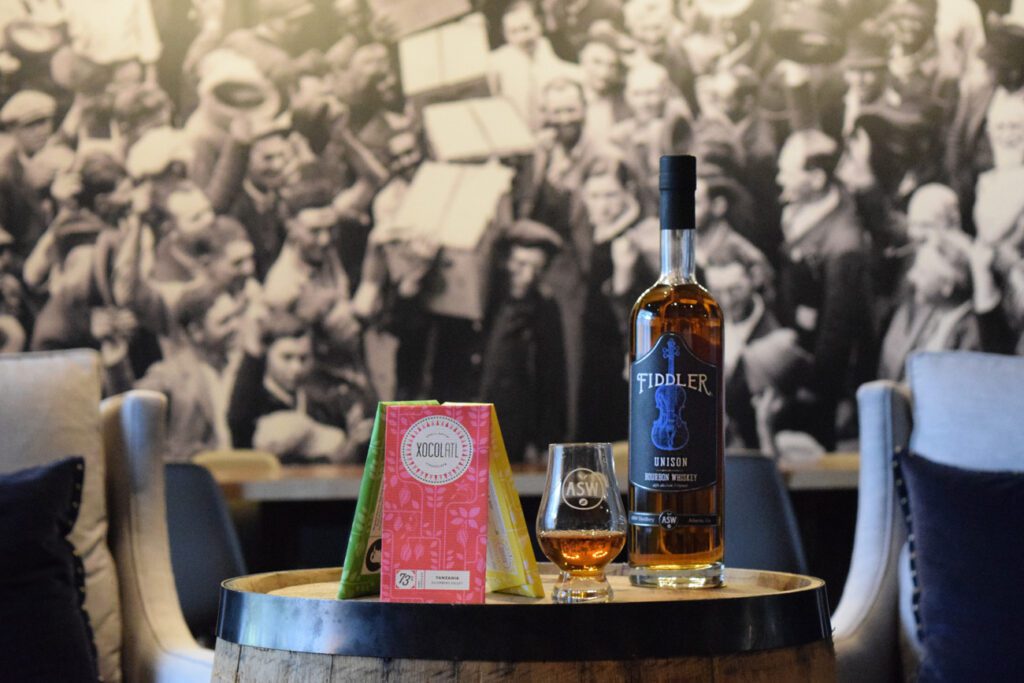AN ALCHEMY OF AROMATICS AND FLAVOR.

It’s well known that wine and cheese are standard bedfellows, but whiskey and chocolate can have quite a courtship as well. Both can bring forth an intense tasting experience on their own. Together, a sort of alchemy happens, transforming them both.
Whiskey is a perfect pairing for chocolate, with the drink’s inherent sweetness and ability to cut through fat. Its high alcohol content enhances aromatics in chocolate, while the fat content of chocolate tempers strong alcohol flavors. Chocolate and whiskey stored in oak barrels even share similar chemistry, both having compounds such as tannins, vanillin and lactones that dominate the aromas in whiskey.
There are two ways to taste chocolate and whiskey: pairing it with similar flavors to bring out similarities or tasting for contrast. While matching similar flavors can reveal deeper essences and characteristics within both, “discordant pairings assault the palate with contrasting flavors,” said Spirits Brand Educator Kaleb Cribb, who works with Atlanta area bartenders and restaurants. The disparity “shocks the palate and makes flavors brighter,” he says.
To begin, get to know your whiskey. Swirl it in your glass to check its “legs.” The faster it moves, the lighter bodied it is. Hold it up to the light and note its color. Nose the whiskey. That is, keep your lips parted and breathe in through your nose to take in aromas. Take a sip and let the whiskey roll around in your mouth for a few seconds. Get acclimated. Then focus on flavors, noting the sweet, the spice, the bitter.
When tasting chocolate, take into consideration the cacao content. This is the number of cocoa solids, cocoa butter and milk (in any form) incorporated in your piece of chocolate. As cacao content increases, the taste is more chocolatey and less sweet. The remaining percentage consists of all the other ingredients (sugar, vanilla, fruit, nuts, salt or other flavorings). Now get to know your chocolate. Take in the scents. Let a piece settle on the middle of your tongue. Chew a little, then hit it with a little bit of whiskey while it’s still on your tongue. As you swallow, discover the evolution of flavor as the two substances interact.
Milk chocolate has a smooth balance of sweet and rich. Its cocoa content is generally low, between 10- 50%, but generally coming in around 40%. It’s a great match for bourbons with a bit of spice. For example, on the palate of Old Forester 100, you’ll find baking spices, caramel and milk chocolate. It’s a seamless match.
Pair milk chocolate or dark with a rye whiskey, and the spice in the rye explodes on the palate. High West’s Rendezvous Rye has notes of oak, cocoa nibs, caramel, allspice and cinnamon that come out when sipped with chocolate. ASW’s Resurgens Rye is floral on the nose, with a little spice and grassiness on the palate. Introduce chocolate, and not only do brilliant spice flavors like cardamom jump out, but it enhances a lot of the chocolate notes from malted rye in the whiskey. Fruity and lighter Scotches such as Speysides also match perfectly with the creaminess of milk chocolate. Pull out the Macallan.
There is no legal definition for dark chocolate, but this category is usually 50-90% cocoa, with most coming in about 70%. This is where whisky comes to play. “The general rule is the smokier or peatier the Scotch, the darker the chocolate,” says Cribb. French Broad Chocolate’s Sea Salt is 75% cacao and is the perfect partner for Talisker Storm, made by the shore on the Isle of Skye. It brings out the fruit notes of the chocolate while simultaneously giving a coastal hit with peat. The warm and peaty aromas of Laphroaig are also an elegant match, bringing forward underlying smoky notes.
Softer and fruitier Scotches pair well with flavored chocolates, especially those with hints of oranges and berries. When pairing a chocolate with nuts, look towards an oak-forward whiskey such as George Dickel Bottled in Bond, with complementary flavors of chocolate, vanilla, caramel and cinnamon on the palate. The flavors of smoke and wood from Scotch disappear into the richness of chocolate, whether bitter or creamy, revealing secondary flavors of both. “It creates something better than the sum of the parts,” says Cribb.
ASW
404.962.8702
aswdistillery.com
@aswdistillery















